Key takeaways:
- Contextual learning enhances understanding by linking theory with real-life applications, fostering engagement and knowledge retention.
- Interactive elements, such as gamification and real-time polling, transform passive learning into an active dialogue, enhancing participant involvement.
- Tailoring workshop content to meet the audience’s specific needs and incorporating hands-on activities are vital for effective learning experiences.
- Success in workshops is measured through participant engagement, immediate feedback, and long-term application of learned concepts in real-life scenarios.
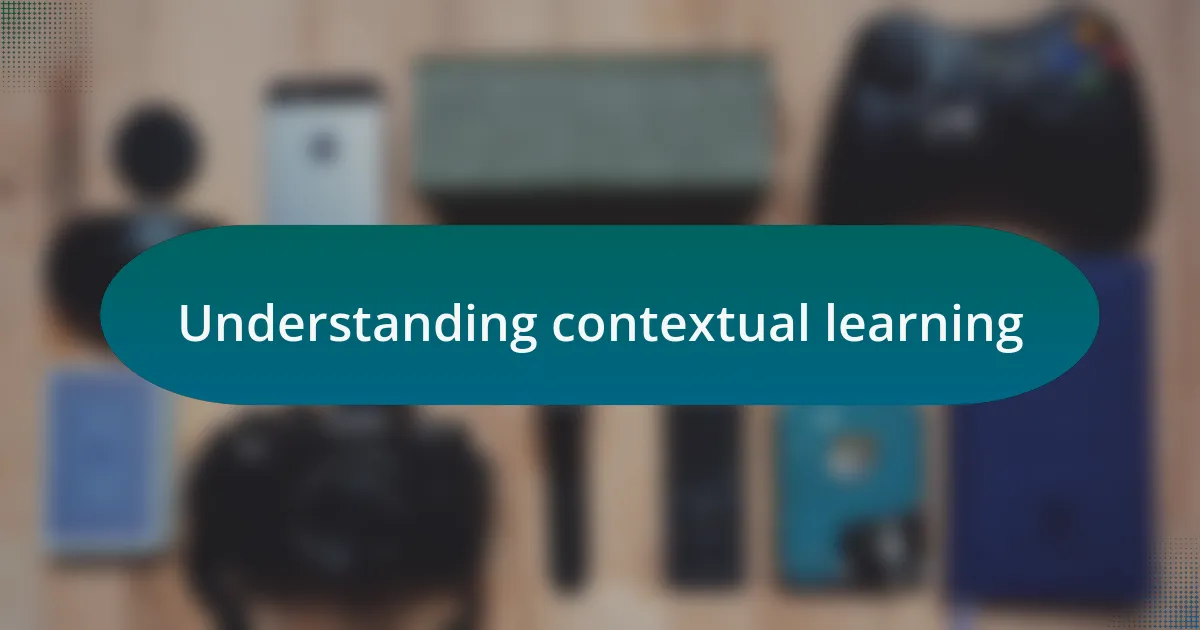
Understanding contextual learning
Contextual learning is a teaching approach that emphasizes the importance of the environment in which learning occurs. For me, it’s like a light bulb moment when I realize how much more effectively I grasp a concept when I see it applied in real-life scenarios. Can you remember a time when theory suddenly made sense through practical application? That’s the beauty of contextual learning.
In my experience, blending real-world problems with theoretical concepts creates an engaging atmosphere where learners feel connected and invested. I once facilitated a workshop on software development where participants analyzed a real project from a local nonprofit. Watching them collaborate to solve actual challenges was not just insightful—it was transformative for everyone involved.
Moreover, contextual learning fosters a deeper understanding by making the information relevant. When learners can relate concepts to their own experiences or future career paths, retention improves drastically. I often ask participants to share their insights. This dialogue enriches the learning experience, as it personalizes education and reinforces the idea that learning doesn’t happen in isolation. Isn’t it fascinating how a shared experience can turn a lesson into a lasting memory?
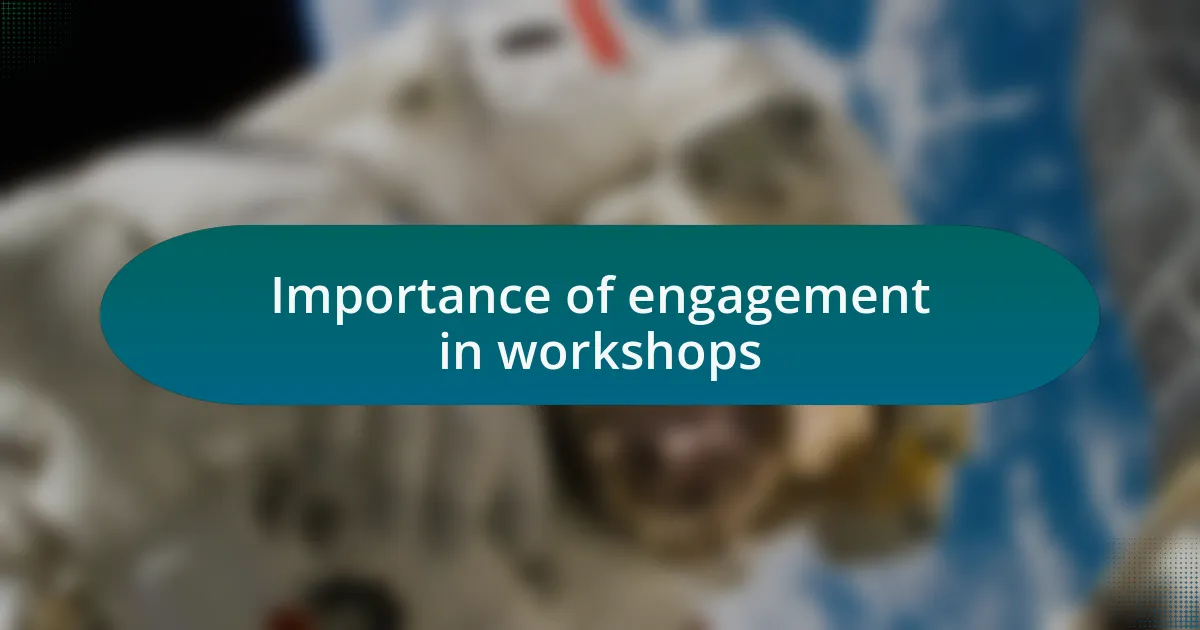
Importance of engagement in workshops
Engagement in workshops is crucial because it transforms a passive learning experience into an interactive dialogue, fostering collaboration among participants. I often recall a workshop where I introduced a gamified element, allowing attendees to solve challenges as teams. The energy in the room shifted completely; suddenly, laughter and excitement replaced the usual reserved demeanor, and I could see that participants were not just absorbing information—they were actively involved in shaping their learning journey.
When participants feel engaged, the likelihood of knowledge retention increases significantly. I remember a session where I encouraged participants to present their own solutions to a case study. The discussions that followed didn’t just deepen understanding; they sparked a sense of ownership in their learning. Have you ever experienced the thrill of sharing an insight that resonated with others? That collective validation not only boosts confidence but also reinforces the material in a way that lectures alone cannot achieve.
Ultimately, engagement serves as the bridge between theory and practice. I often hear from past participants—those who once felt indifferent about a topic—about how their newfound enthusiasm propelled them into further exploration. It’s a beautiful reminder that when we connect on a personal level, the information sticks. Isn’t that the goal of every workshop? To inspire participants to not just learn, but to ignite a passion that drives them beyond the event itself?
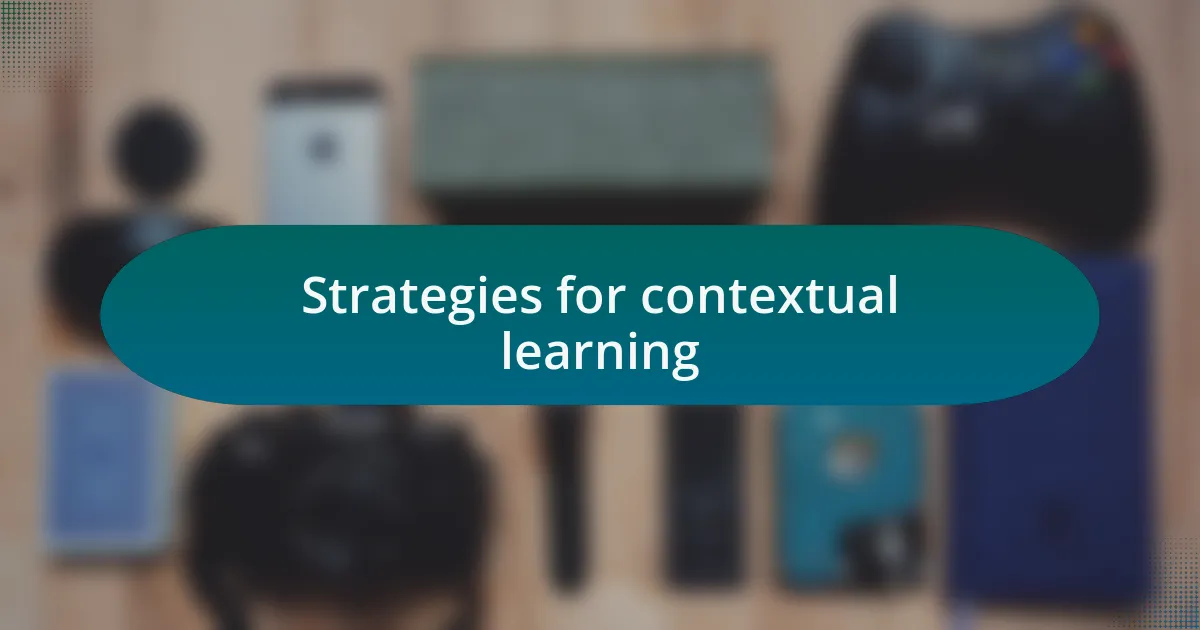
Strategies for contextual learning
Creating an environment where contextual learning thrives starts with relevant examples. I often incorporate scenarios that mirror real-life situations participants might face in their daily work. For instance, during a recent tech workshop, I presented a case study from a well-known company navigating a digital transformation. The participants instantly related to it, sparking passionate discussions that I had not anticipated. Isn’t it fascinating how a relatable scenario can instantly change the dynamic of a workshop?
Another effective strategy is to leverage group activities that encourage peer learning. In one workshop, I divided participants into small teams to tackle problem-solving tasks specific to their industries. I noticed how their unique perspectives collided, leading to innovative solutions and deeper understanding. This collaborative spirit not only enriched the learning experience but also fostered connections between attendees. Have you ever encountered a moment where teamwork led to a breakthrough idea? Those shared “aha” moments are often the most memorable.
Lastly, integrating reflection time can significantly enhance contextual learning. I learned this the hard way when I once skipped this step in a workshop. I realized participants were buzzing with ideas, but without the time to reflect, the information quickly became overwhelming. Now, I always build in a few minutes for participants to jot down insights or questions about what they’ve learned. This practice not only solidifies knowledge but also empowers participants to take ownership of their learning journey. Reflecting on experiences truly enriches the entire process, doesn’t it?
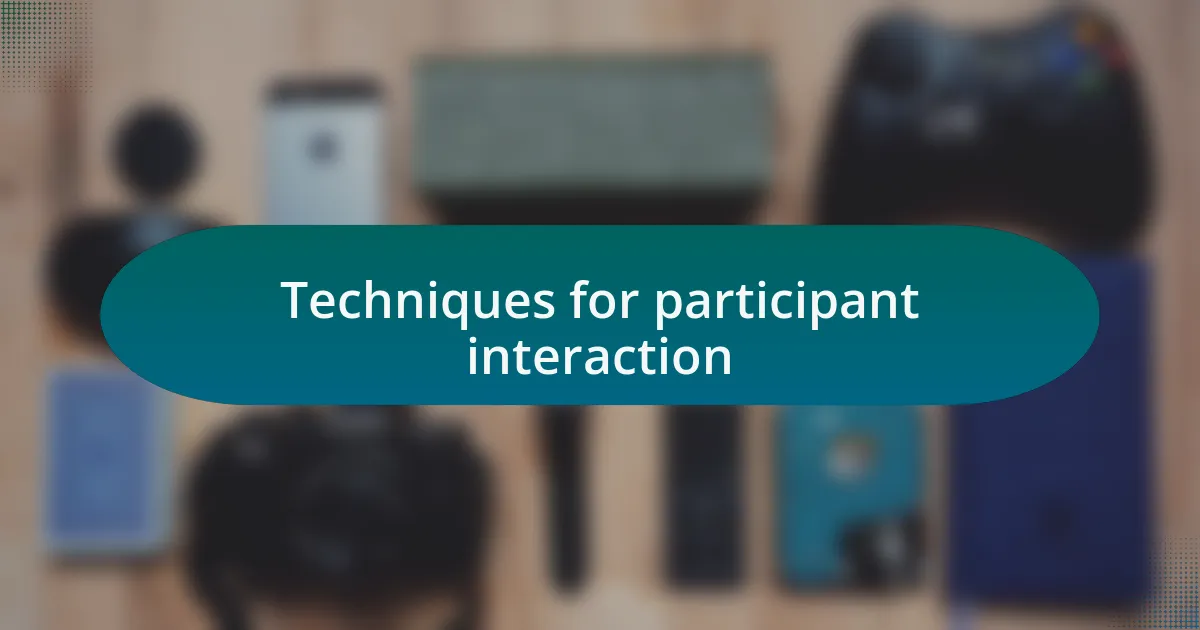
Techniques for participant interaction
When it comes to participant interaction, one technique that has consistently proven effective is the use of real-time polling. During a workshop on emerging technologies, I utilized an interactive polling tool to gauge the audience’s familiarity with AI concepts. Watching their responses come in live was exhilarating, as it turned the atmosphere from passive listening to active engagement. Have you ever felt the energy shift when participants realize their opinions matter? It truly transforms the learning environment.
Incorporating role-playing scenarios can also be a game changer. I once led a session on cybersecurity threats where I assigned participants specific roles, such as a hacker or a security analyst. As the simulation unfolded, participants were not only entertained but also gained profound insights into the challenges each role faces. It’s amazing how stepping into someone else’s shoes can foster empathy and deepen understanding. Have you experienced that moment of sudden clarity when you view a problem from a different perspective?
Another technique I’ve found invaluable is storytelling. I recall sharing a personal anecdote about a tech project that didn’t go as planned, illustrating both my mistakes and the lessons learned. This approach not only made the content relatable but sparked heartfelt discussions among participants who had faced similar challenges. It raises an important question: Why do we connect more with stories than with data alone? The emotional resonance of a well-told story can make the learning stick in ways that statistics often cannot.
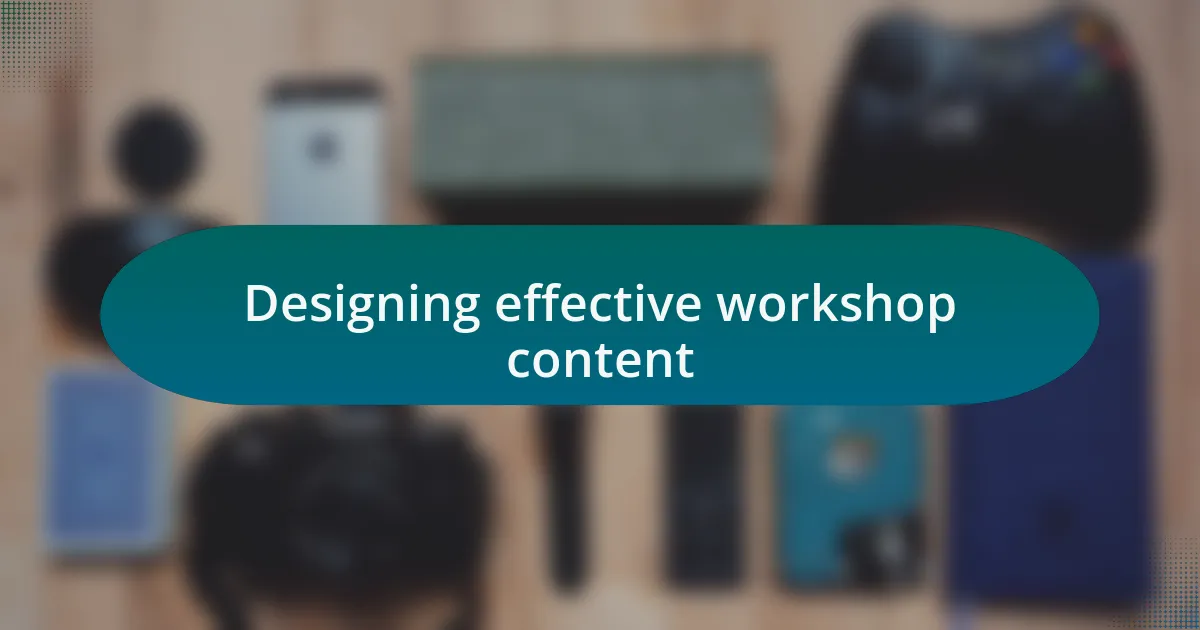
Designing effective workshop content
Designing effective workshop content starts with understanding the unique needs of your audience. I once tailored a session for software developers focused on best practices in coding. By incorporating their specific pain points and challenges into the material, I noticed an immediate increase in interest and participation. How often do we overlook the importance of customization? It really is key to engaging participants meaningfully.
Another crucial element is the sequencing of content. While working on a workshop about data privacy, I structured the material incrementally, starting with fundamental concepts before progressing to advanced topics. This gradual buildup created a comfortable learning curve, allowing participants to absorb the information effectively. Have you ever felt overwhelmed by content that jumps right into the deep end? I think many can relate to that frustration.
Incorporating hands-on activities is also essential. During a recent workshop on machine learning, I implemented small group exercises where participants could experiment with real data sets. The buzz of excitement and collaboration in the room was palpable. Isn’t it fascinating how active participation can lead to deeper understanding? I’ve found that when participants can apply concepts in a practical way, the learning experience becomes not just memorable but transformative.
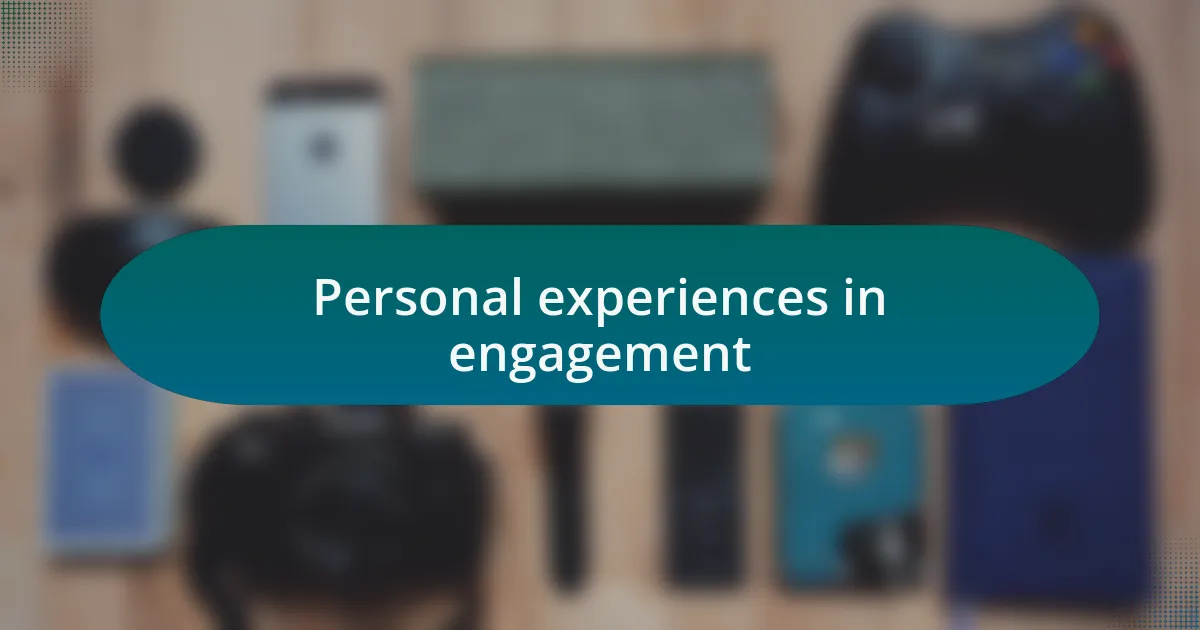
Personal experiences in engagement
Engagement is often at its peak when participants can relate personally to the material. I recall facilitating a workshop on emerging technologies where I shared a story from my early career about failing to embrace change. As I opened up about my struggles, I noticed participants nodding in understanding. It was a revealing moment; when we connect on a human level, barriers dissolve, making it easier for them to engage with the content.
I’ve also experimented with interactive storytelling. During a recent seminar, I introduced a case study from a real tech startup that had innovative solutions to common industry challenges. As I guided the audience through that journey, their faces lit up with recognition and curiosity. Isn’t it incredible how narratives can transform abstract concepts into relevant experiences? This approach made the information feel less like a lecture and more like a valuable conversation.
Despite all the efforts in design, I’ve found that seamless engagement often hinges on the energy in the room. I once had a workshop where an unexpected debate erupted over a controversial tech trend. Instead of steering it back, I let the conversation flow. Embracing that spontaneity not only kept everyone on their toes but also deepened their investment in the topic. How often does a simple dialogue elevate understanding and foster connections? I believe it’s moments like these that make workshops truly unforgettable.
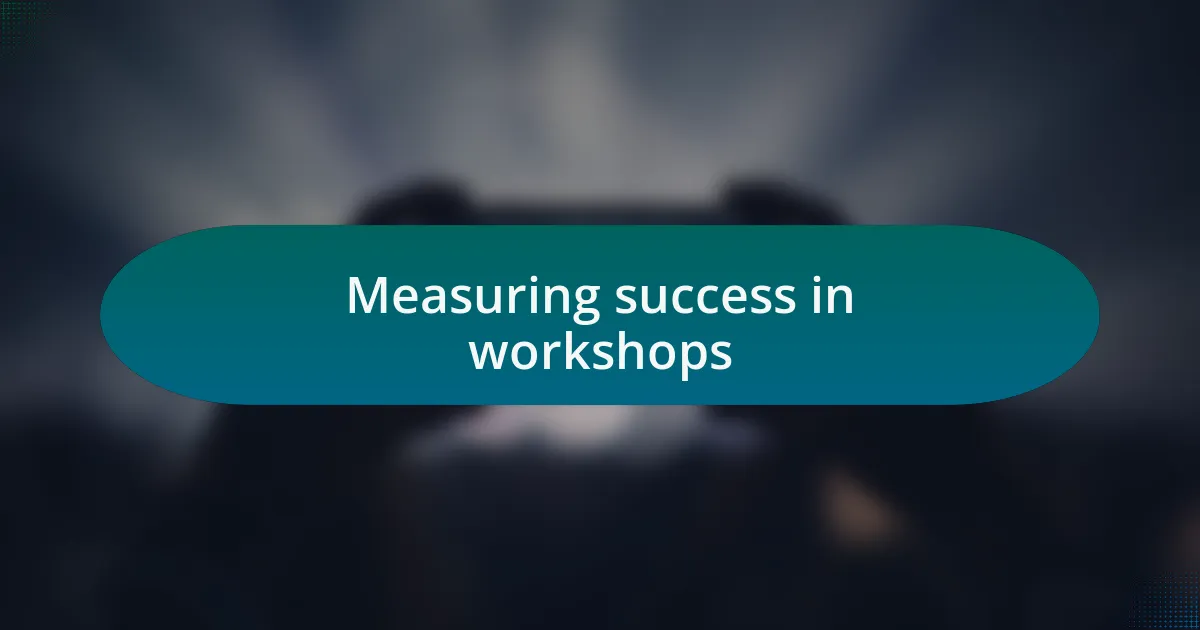
Measuring success in workshops
Measuring success in workshops often requires both qualitative and quantitative metrics. For instance, after a two-day workshop on artificial intelligence, I distributed a simple survey asking participants to rate their understanding of key concepts before and after the sessions. The increase in scores was not just a number; it was a clear indication that the strategies I employed truly resonated with them.
In my experience, follow-up conversations can be just as telling as immediate feedback. After one workshop, I reached out to several participants a month later to see how they had implemented the techniques we discussed. Their responses reminded me that the true success of a workshop isn’t just in what is learned but how participants apply that knowledge in real-life scenarios. Isn’t it rewarding to see the seeds of knowledge take root beyond the event?
Another essential measure is the level of enthusiasm I observe during sessions. I vividly recall a workshop where the energy was palpable; participants were not just absorbing information but actively engaging with it, asking questions and contributing ideas. This vibrant atmosphere signaled to me that the workshop was a success in fostering an environment of shared learning and exploration. Wouldn’t you agree that when the participants leave feeling inspired, that’s when you know you’ve hit the mark?